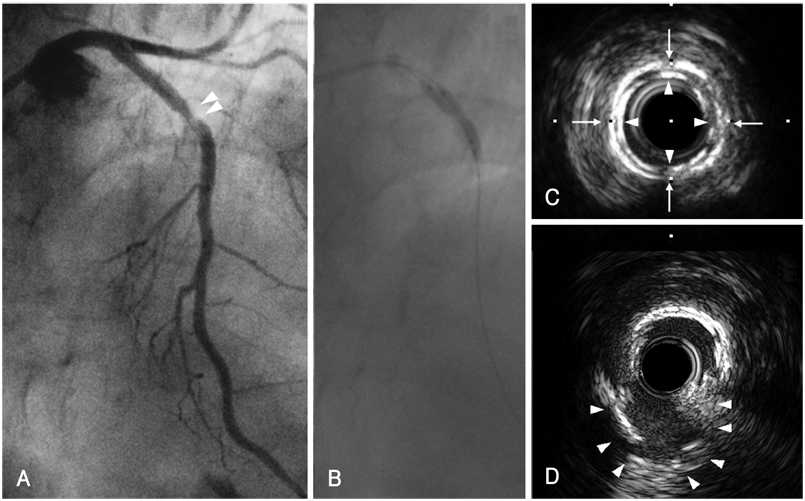Korean Circ J.
2009 Nov;39(11):499-501. 10.4070/kcj.2009.39.11.499.
Effectiveness of the Hugging Balloon Technique in Coronary Angioplasty for a Heavy, Encircling, Calcified Coronary Lesion
- Affiliations
-
- 1Department of Cardiology, Pusan National University School of Medicine, Busan, Korea.
- 2Department of Cardiology, Wonju College of Medicine, Yonsei University, Wonju, Korea. jyoon@yonsei.ac.kr
- KMID: 2225654
- DOI: http://doi.org/10.4070/kcj.2009.39.11.499
Abstract
- We report our experience in coronary angioplasty and intravascular ultrasonography (IVUS) on a heavy, encircling, calcified lesion that was not dilated with the use of a cutting balloon and a non-compliant balloon. The angioplasty was successfully performed with a simple and inexpensive hugging balloon technique.
Figure
Reference
-
1. Mintz GS, Potkin BN, Keren G, et al. Intravascular ultrasound evaluation of the effect of rotational atherectomy in obstructive atherosclerotic coronary artery disease. Circulation. 1992. 86:1383–1393.2. Kim MH. Initial experience of rotational atherectomy in coronary artery disease. Korean Circ J. 1999. 29:567–574.3. Abbo KM, Dooris M, Glazier S, et al. Features and outcome of no-reflow after percutaneous coronary intervention. Am J Cardiol. 1995. 75:778–782.4. Karvouni E, Stankovic G, Albiero R, et al. Cutting balloon angioplasty for treatment of calcified coronary lesions. Catheter Cardiovasc Interv. 2001. 54:473–481.5. Quan VH, Stone JR, Couper GS, Rogers C. Coronary artery perforation by cutting balloon resulting in dissecting subepicardial hematoma and avulsion of the vasculature. Catheter Cardiovasc Interv. 2005. 64:163–168.6. Bassand JP, Schiele F, Bernard Y, et al. The double-balloon and Inoue techniques in percutaneous mitral valvuloplasty: comparative results in a series of 232 cases. J Am Coll Cardiol. 1991. 18:982–989.7. Morino Y, Yamamoto H, Mitsudo K, et al. Functional formula to determine adequate balloon diameter of simultaneous kissing balloon technique for treatment of bifurcated coronary lesions: clinical validation by volumetric intravascular ultrasound analysis. Circ J. 2008. 72:886–892.
- Full Text Links
- Actions
-
Cited
- CITED
-
- Close
- Share
- Similar articles
-
- Two Cases of Coronary Pseudo-Lesion Induced in the Left Circumflex Artery and the Right Coronary Artery by the Angioplasty Guide-Wire
- Angioplasty at Coronary Bifurcation
- Coronary Irradiation for the Prevention of Restenosis after Percutaneous Transluminal Coronary Angioplasty
- Experience in High Speed Rotational Coronary Atherectomy
- Catheter Interventions for Kawasaki Disease: Current Concepts and Future Directions



